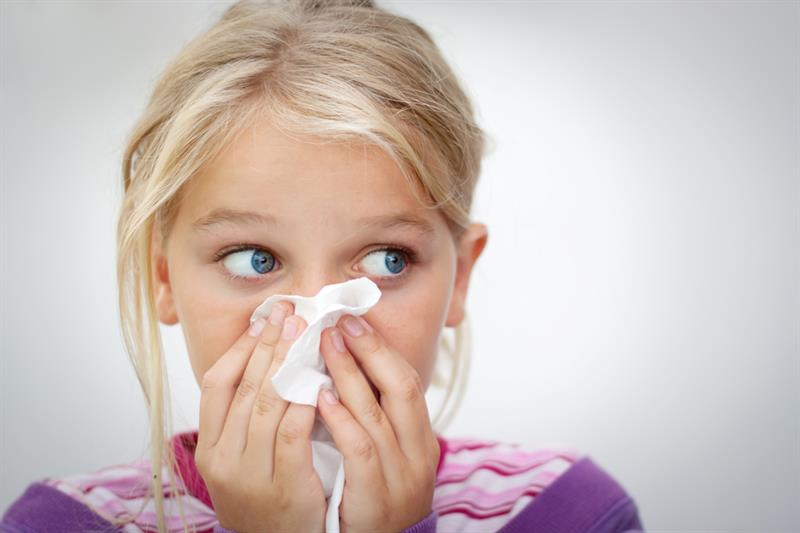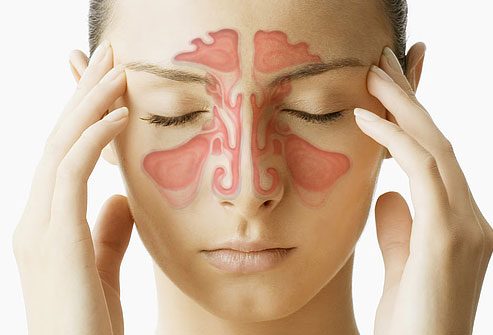Sinusitis Disease refers to the inflammation of the mucous membranes which cover the interior of the sinuses. The sinuses are bone cavities (distributed in 4 pairs) located in the bones of the face. Each sinus communicates with the nasal passages through small openings, which normally flows the mucus produced in the sinuses.
Inflammation of the sinus mucosa, also called rhinosinusitis, is usually caused by a viral or bacterial infection. When a virus or bacteria spread in the sinuses, the mucus membrane is irritated and swollen, which can block the sinuses. The mucus is then no longer drained regularly to the nose, and, in this closed medium, the microbes multiply freely. The pain and sensation of pressure in the face, well known to people with sinusitis, originate from the accumulation of mucus inside the sinus/es. Sinusitis is a common condition, but its prevalence is difficult to estimate. According to some studies, it affects between 10% and 15% of the population, both adults and children.
Note: Each sinus bears a different name depending on its position. Thus, according to the infected sinus, we speak of frontal sinusitis, maxillary sinus, left sphenoid (if only one side is affected), etc.
Types of Sinusitis
1. Acute sinusitis: It does not last more than four weeks and does not reappear more than three times a year. In most cases, it follows a viral infection of the upper respiratory tract, usually a cold. In Canada, between 0.5% and 2% of people with colds contract sinusitis. Other possible causes or factors include:
- A bacterial or fungal infection (by fungi)
- Allergies
- A dental abscess that spreads to the sinuses
- The atmospheric pollution
- Nasal polyps
- A deflection of the nasal wall
2. Chronic sinusitis: Sinusitis becomes chronic when it persists beyond 12 weeks (we speak of subacute sinusitis between 4 and 12 weeks). If acute sinusitis does not respond to the usual treatments or if it is not treated, it may evolve into chronic sinusitis. In general, chronicity occurs after several outbreaks of acute sinusitis (recurrent sinusitis); however, sometimes acute sinusitis immediately evolves towards chronicity. Most commonly, chronic sinusitis is due to allergies. These include allergies to pets, dust mites, pollen, fungi, or other substances that cause inflammation of the nasal and sinus walls. Thus, 50% to 80% of people with chronic sinusitis are allergic or have allergic rhinitis.

Sinusitis Disease: Other factors may be involved
- Active or passive smoking
- A weak immune system
- Cystic fibrosis
- An anomalous anomaly: an abnormal shape of the small canals allowing the sinuses to communicate with the nasal cavities or a deflection of the nasal septum
- Nasal polyps
- Swimming (irritation due to chlorine)
- The use of cocaine nasally
- Facial trauma obstructing one or more sinuses
- Exposure to irritating chemicals (such as formaldehyde)
- Untreated gastroesophageal reflux (especially in children)

Complications
In rare cases, the sinus infection can spread to the eyes or the brain, which can cause the following problems:
- Meningitis
- An abscess to the brain
- Thrombophlebitis of the veins of the eyes
- Osteomyelitis of the frontal bones (especially in children)
- Besides, untreated or chronic sinusitis may exacerbate respiratory problems in people with asthma, especially in children.

Symptoms of Sinusitis
Typically, sinusitis appears after a cold, which seems cured or on the way to recovery and is complicated by a sinus infection.
1. Typical Symptoms
- Facial pain (above eyebrows, nose, cheeks, around and behind the eyes)
- Painful sensations of pressure in the sinus area or on one side of the face
- Nasal congestion
- Thick, purulent yellowish or greenish nasal secretions in the case of bacterial infection
- If the secretions are clear, it is rather a viral infection (for which antibiotics are of no use)
- A slight fever and general malaise
- A decrease or a loss of sense of smell
2. Other Symptoms
- Bad breath
- Headaches
- Pains to the teeth and the upper jaw
- A greasy cough, because the secretions tend to end up in the throat
3. Further notes
- The pain is accentuated when the head is tilted downwards.
- In the case of chronic sinusitis, the symptoms are the same as those of acute sinusitis, but they last longer and there is no fever.

The prevention of sinusitis
Sinusitis, which usually lasts longer than a cold, can be very painful and cause serious complications. People who know they are at risk, including those who have had sinusitis, can reduce their risk of re-offending. Preventive measures help prevent the progression of chronic sinusitis.
1. Measures to prevent sinusitis
Some measures reduce the risk of contracting the disease once, or again or have chronic sinusitis. For the most part, these are:
- Prevent the cold by the usual means: wash your hands thoroughly, avoid contact with people who have a cold.
- Prevent allergies by exposing as little as possible to allergens (pets, pollen, mites, etc.)And the pollutants that usually affect us.
- Have a balanced lifestyle in terms of stress, physical activity, food, etc. More info Strengthen the immune system.
- Avoid smoking or exposing yourself to tobacco smoke, which irritates the sinuses.
- Avoid the use of decongestants in the form of nasal sprays (Dristan®, Otrivin®) for more than three days, as they can cause addiction and nasal congestion of “rebound.” Moreover, in some people, they irritate the fragile mucosa of the nose. Decongestants are taken orally cause fewer problems in the nasal mucosa but may have troublesome side effects (worsening hypertension). Plus, their effectiveness is disputed.

2. Measures to prevent complications
Seeing a doctor for accurate diagnosis and taking the necessary measures to treat sinusitis usually helps prevent complications (meningitis, osteomyelitis, etc.). Monitor the following signs, which indicate a complication:
- Abnormal vision (sometimes double vision)
- Swelling around the eyes
- A change in the state of consciousness
Do not urge your doctor to receive antibiotics if not necessary. Most sinusitis is of viral or allergic origin, and therefore, can not be treated with antibiotics, which only fight bacteria.


